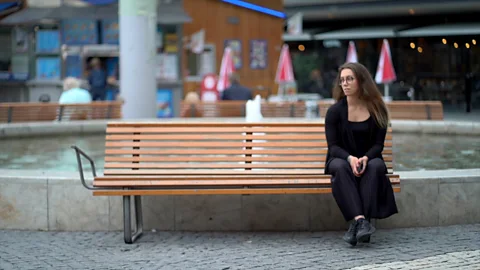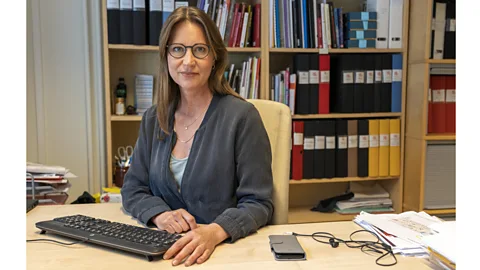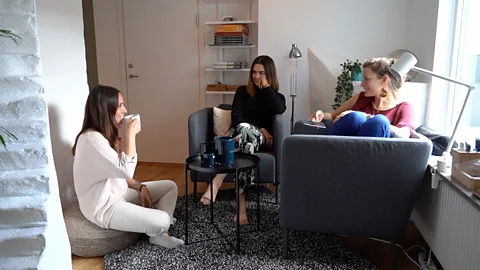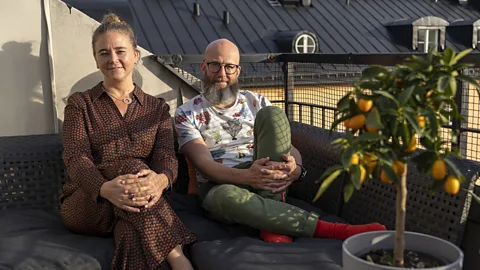Why so many young Swedes live alone
 Benoît Derrier
Benoît DerrierSwedes typically stop living with their parents earlier than anywhere else in Europe. But can leaving home at a young age have a dark side?
As we head into 2020, we're running the best, most insightful and most essential Worklife stories from 2019. Read all of the year's biggest hits here.
Fleeing the family nest is a rite of passage many teenagers dream of, yet it’s a luxury millennials and Generation Z across much of the Western world are having to wait much longer for.
In the US, more young people are living with their parents than at any time since 1940, according to a recent Pew Research Center analysis of census data. A 2019 study by British think tank Civitas found that the proportion of 23-year-olds living with their parents in the UK had risen from 37% in 1998 to 49% a decade later.
In Sweden it’s a different story. The most common age to leave home is between 18 and 19, compared to the EU average of 26, according to Eurostat figures. And a significant proportion of these young Swedes aren’t moving into cramped house shares or student dorms. They are living alone.
“I’d always wanted to move out of home and I’d always felt ready,” says Ida Staberg, who has been renting an apartment by herself in Vällingby, a suburb north-west of Stockholm, for two years, since she was 19.
Video by Maddy Savage and Benoît Derrier.
It’s a sparsely-decorated studio – just a few photos and a wire butterfly hanging on the wall – around 30 sq m in size. She has a long-term rent-controlled contract that costs her around $850 (8,000 kronor) a month, which she pays from her salary working for a security firm. Her parents and two younger siblings live about an hour away on the other side of the city.
“To know I can look after myself and I have power over my own life, without being guided by my family or my siblings and their timetable,” are the main benefits, she argues.
More than half of Swedish households are single-person, the highest proportion in the EU, according to Eurostat. Official figures given to the BBC by the Swedish government’s number-crunching agency Statistics Sweden suggest that includes around one in five 18- to 25-year-olds, although its researchers estimate that the real number could be higher, since many remain registered at their parents’ address while they stay in sublet rentals.
 Alamy
AlamyThe norm of moving out at a young age has even persisted during a major housing squeeze. Long queues for rent-controlled accommodation and a pricey subletting market have made it harder to find affordable apartments in major cities and forced some to delay fleeing the nest. But the proportion of young people living by themselves has barely changed since 2011, according to Statistics Sweden.
“It is special in Sweden – and the Nordics – that there is much less variation in leaving age than other countries,” explains Gunnar Andersson, professor of demography at Stockholm University.
“In other parts of Europe it’s not considered problematic to depend on your family and in southern Europe it should even be considered a goal – if you don’t, it would be like rejecting your family,” he says. “In Sweden...it’s the goal to create an independent individual...there’s seen to be something wrong if the child stays at home.”
Andersson explains that Sweden’s “culture of individualism” dates back centuries, with teenagers in rural communities typically leaving home to go and work on another farm. In more recent years the norm of young people living alone has, he says, remained realistic thanks to Sweden’s strong welfare state which, in theory, should enable them to have access to affordable housing, healthcare and education without relying on relatives or partners for help.
Meanwhile, he says that the housing stock in Swedish towns and cities, which is largely made up of compact apartments, “helps maintain” this norm. By contrast, in urban hubs like London, Paris or New York there are numerous converted townhouses that make sense for young professionals to share.
 Benoît Derrier
Benoît DerrierLiberating or lonely?
But while many young Swedes enjoy the kind of social and financial freedom that might sound like fantasy to many global peers, there are concerns that fleeing the nest so soon can have its downsides.
Karin Schulz, general secretary of the Swedish mental health charity Mind, argues that while “it's great for young people to be able to be independent,” Sweden’s focus on moving out after high school can have a damaging impact on those who are not yet mentally equipped to live alone.
“For some they're not really ready for it...You have a lot of things to think about, a lot of decisions to make and it is a struggle for many,” she explains.
Ida Staberg, now 21, experienced problems with budgeting and administrative tasks when she first moved into her apartment in Vällingby.
“I realised quickly that there was a lot to think about,” she explains. “In the beginning I didn’t even know how to pay a bill and then there’s also the stress of getting money together yourself, but also things like when the washing up liquid runs out and you can’t do the dishes, or the toilet paper doesn’t refill itself.”
According to Schulz, “emotional loneliness” is another challenge. While most teenagers have active social lives and large networks on social media, she says some can struggle with moving out if they don't have a close friend or relative “to really talk about their life and their emotions to”.
 Benoît Derrier
Benoît DerrierDespite Sweden’s global reputation for prioritising family life when children are small, Schulz believes that parents are often more focused on offering “practical rather than emotional” support once their offspring move out. A 2017 study by Statistics Sweden found that more than 55% of 16 to 24 year-olds don’t socialise with any close relatives.
“We hear a lot that they [young people] don't have any adults that are courageous enough and open enough to really talk to them and take the initiative to really ask them how they are.”
Schulz says it’s not possible to draw clear links between loneliness and specific mental health diagnoses. But the number of young adults aged 16 to 24 given treatment for psychiatric illness in Sweden has risen by nearly 70% over the past decade, according to figures released by Sweden’s National Board of Health and Welfare in 2018.
Christoffer Sandström, 26, who has lived alone since he was 21, has been vocal about his struggles after relocating to a rented flat in Stockholm from Sundsvall, a city around 380km north.
“It tore on my mental health a bit and I felt more isolated than ever in my life,” he says. “I lost energy, and was feeling a bit more sad and not as excited in the morning or when the sun rose. I just wanted to make time go faster and get through the day.”
He shared a house with friends during travels in Australia and says he found this less of a challenge. “There is a lot of pressure on young people [in Sweden] to be an adult and act like an adult,” he argues. “But it is more difficult to live by yourself than with friends and family.”
He says he feels better since making a good group of friends at work and joining sport activities. “I still feel lonely sometimes, but it is a bit less now.”
For Ida Staberg, the novelty of being independent also wore off quickly, and mental health problems she’d experienced as a younger teenager started to resurface. “I felt alone and did not have anyone close by,” she explains. “It was like an emptiness...It became easy to start thinking bad things about myself, or destructive thoughts.”
 Alamy
AlamyThere has not been a nationwide survey of loneliness since 2013, but that research for Statistics Sweden found that 16.8% of 16 to 24 year-olds said they had “felt alone during the last two weeks”. Only Swedes in the over-75s category reported higher levels of loneliness (17.4%).
Dr Filip Fors Connolly, a sociologist at Umeå University in northern Sweden and co-author of the book chapter The Swedish Loneliness, argues that living alone is “definitely a factor” when it comes to perceived levels of emotional loneliness among young Swedes.
However, he warns that the bigger picture is more complex. For example, young people may tend to report feeling lonelier than more mature single household dwellers regardless of their objective social situation because they are “more insecure in themselves” at that age.
Plus it could be that young Swedes are increasingly raising concerns about loneliness because they are more comfortable talking about their needs and feelings than previous generations. Fors Connolly says it is therefore “not clear that the present generation feels lonelier compared to previous generations”.
Meanwhile, other research suggests that the tendency to live alone in Sweden has not left it a lonelier nation than European neighbours. In fact, the latest European Social Survey, released in 2014, found that only 5% of Swedes experienced frequent loneliness, slightly lower than the European average of 7%.
A new kind of shared living?
Yet despite a lack of hard data on the issue, loneliness as a potential social and health problem for young Swedes is increasingly generating discussion.
Sweden’s largest daily newspaper Dagens Nyheter recently ran the headline ‘Is loneliness among young people a new epidemic?’, while the Red Cross has increased resources for tackling loneliness among different age groups. One Nordic start-up, No Isolation, has been campaigning for the government to appoint a loneliness minister. The issue is also having an impact on discussions about integration; Sweden frequently comes close to the bottom of global rankings when it comes to the ease of making new friends.
There is a slow-burning public debate about whether shifts in Swedish housing and socialising habits might help tackle the issue. In larger cities, this includes a bubbling movement championing shared living.
 Benoît Derrier
Benoît DerrierIn 2011, one of Stockholm’s limited medieval townhouses, named Hus 24, became the first property in the Nordics to be formally branded a co-living space. Launched by Lisa Renander, an entrepreneur who felt lonely when she moved back to Sweden from Silicon Valley, the building has 12 spots for young professionals looking for a shared home. A sister property, K9, was launched five years later – a disused hotel renovated to hold 50 professionals who have so far included lawyers, consultants, teachers, bartenders and professional dancers alongside start-up workers.
The latest venture to make waves, Colive, opened its first 11-person property in May 2019 in an airy converted attic in Södermalm, one of Stockholm’s hippest city-centre neighbourhoods. Here, the cost of a small double bedroom is around the same as Ida Staberg’s studio in Vällingby (around $850 a month).
“Co-living (provides) a social arena for a lot of people that get lonely,” argues co-founder Katarina Liljestam Beyer. She says that addressing loneliness is a major goal of the company, alongside providing a solution to Stockholm’s long queues for affordable apartments – and its long winters.
“In Sweden it's really dark in the evenings (during the winter) and you don't feel like going out during the week, which makes some people feel isolated. If you already live with other people, you have your dinner company under the same roof as your own room. If you don’t want to socialise, you can just close your door.”
“As far as quality of life goes, it just gives much more joy to be around other people – especially if they're like-minded,” agrees 25-year-old Katrine Bimell, a virtual reality architect who is one of the initial housemates, carefully screened from hundreds of applicants.
 Benoît Derrier
Benoît DerrierShe says she was “feeling alright” when she lived alone in her late teens and early 20s, but experienced a major shift in her mood when she started co-living. “There was such a contrast... because then the life at home became much more colourful.”
Colive wants to create tens of thousands of co-living units within a decade, aimed at 18- to 30-year-olds from all backgrounds, and believes there is a strong market. A 2014 report by innovation consultancy United Minds suggested almost half of 18 to 35 year-olds in Stockholm would be interested in sharing with friends or others outside their immediate family and Katarina Liljestam Beyer says the company’s own research has backed up the findings.
It is perhaps no coincidence that the co-living trend has emerged in tandem with a boom in apps finding other innovative ways to encourage Swedes to socialise. These include Panion, which allows users to search for friends with similar interests and join group activities, and GoFrendly, a women-only platform that matches users with like-minded people in their area. The number of co-working spaces has also mushroomed, reflecting the growing numbers of Swedes starting their own businesses or joining the gig economy, yet seeking the community of a shared space.
But just how mainstream co-living will become in Sweden remains up for debate. Housemate Katrine Bimell says people have been discussing the concept at parties “since a few years back” and is hopeful it will continue to grow.
“There is a reaction going on in people who are looking for a different context from living on their own,” she reflects. “It’s [happening] among different communities as well, with different values. It seems they [co-living spaces] are spreading here and all over the city.”
 Benoît Derrier
Benoît DerrierHowever demography professor Gunnar Andersson believes it is unlikely that collective housing projects will become mainstream any time soon, due to Sweden’s deep-rooted culture of individualism. Previous generations have also tested the idea, without it taking off on a large scale.
“Everybody seems to agree that this would be something great, in theory that is,” he argues. “In real life hardly anything seems to happen... probably because the arrangement doesn’t, after all, fit the Swedish logics and mindset.”
Meanwhile plenty of young Swedes say they wouldn’t trade their experience of living alone.
“In Sweden we like to feel like individuals. I think it’s a good thing – we are not as co-dependent as others,” says Jonna Lundin, who moved into a one-bedroom apartment in Stockholm aged 19 to attend university. “For me it was a way to get to know myself and what I want and what I like and don’t like.”
Her boyfriend has recently moved in, but she says she was rarely lonely or bored while living solo and couldn’t imagine returning to her parents or living in collective housing if her relationship didn’t work out.
And back in Vällingby, Ida Staberg argues that even after her own struggles with loneliness, she wouldn’t change what she’s been through. “Even if it is tough sometimes and difficult and feels lonely... it teaches you a lot and develops you a lot,” she says. “So I think it is something positive”.
Her words recall an old Swedish proverb: “ensam är stark” – “alone is strong”.
